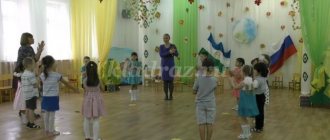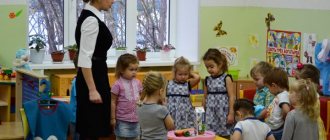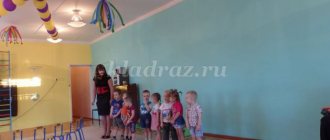How to get children interested in an activity: examples of a motivating start
The introductory or introductory part is where your lesson will begin. Despite the short duration (from three to five minutes), it is this part that will largely determine how much the music director will interest his students and how exactly they will tune in to the lesson. In a short time, it is important to do the following:
- It is important to show children that it is time for class. They must calm down and remember the rules of behavior during the educational process.
- Next, the children can sing a song, if there is such a ritual, a hero, a picture may appear, music may play, which will captivate the children in the learning process. How children prepare for a lesson is very important. These must be positive emotions. If too much time is spent on poetry and a song, then everyone together, the children and the music director, can simply stand in a circle and wish each other something nice, or just smile. Such a ritual can be changed periodically, but not often; it is at the subconscious level that will allow children to finally calm down and tune in to the lesson. You can finish your training with the same ritual.
- It is important to outline the goals of this lesson.
Just because a child is determined to engage in a lesson does not mean that he is interested. A game is the simplest method of attracting interest. Here are a few examples of a motivating start to a lesson that a music director can use to diversify learning:
- "Help the toy." By solving the toy problem, the child achieves the learning goal. Children are told about the problem with the toy, calling on them to help. You ask the children if they agree to help the toy. It's always important to create choice. You propose to teach children to do what the toy requires, then the explanation and demonstration will interest the children. Each child can have his own character - a ward (a cut-out, toy, drawn character whom he helps). With this motivation, the child acts as an assistant and protector, and it is appropriate to use it for teaching various practical skills.
- "The story about La." Before the lesson, the notes A (a note sign with a signature) were “hidden” in the room. You need to draw attention to the fact that there is someone else in the room, prompting the children to search. When they find all the notes - each with an “A” - they need to remember that there are only seven notes, and since there is only one A, she must be very lonely. You can practice the note “A” on different instruments, replace the words of a song with this sound, pronounce it during a round dance, train your breathing by singing a drawn-out “A”, thus paying maximum attention to the note. At the end of the lesson, children can pick up their sheet music to continue caring for it.
- "Help me". Here, the motive for children is communication with an adult, the opportunity to gain approval, as well as interest in joint activities that can be done together. This technique is suitable if the fairy of Music comes to visit - the favorite hero of music lessons, who often asks for help getting to the land of Music - or another fairy-tale character. You tell the children that the hero needs help. Each child is given a feasible task. At the end, you emphasize that the result was achieved through joint efforts.
- "Teach me". The musical director should or the main character of the events - some fairy-tale character - should ask the children to master some new task, either known to the child or simply to be performed. It is imperative that each student makes his own personal contribution, which should also be separately assessed and praised.
- “Dunno forgot everything.” Dunno comes to visit the children. He talks about his problem - all the fairy-tale characters laugh at him because he has forgotten all the songs that there are in the world. He asks the children to help him. You need to know a New Year's song, a birthday song, an autumn song, a summer song, and a round dance song. The children are invited to independently choose which song they will teach Dunno, then everyone goes out to the hero, drinks part of the song, Dunno begins to sing along, inviting everyone else to follow his example. Songs may be accompanied by playing a musical instrument and dancing.
Music lessons are very important for young children, they help develop mental abilities and memory.
All kids love music lessons
Author: Evgenia Aleksandrovna Seibert, music director
Institution: MBDOU kindergarten No. 6 “Vasilyok” Locality: Karasuk
Topic: “Colors of Autumn” Purpose: To consolidate knowledge about autumn as a time of year. Develop auditory attention, musical responsiveness, motor activity, creative imagination. Objectives: 1. Educational: - improve vocal skills; - enrich children with musical experiences through listening and singing. 2. Developmental: - develop a sense of rhythm, auditory attention; - promote the development of memory, logical thinking, imagination; — develop children’s creative abilities and communication skills. 3. Educators: - cultivate a positive attitude towards music and nature. Equipment: box with fake pencils, homemade musical instruments, easel, white leaves, plume, sets of colored pencils.
Progress of the lesson
Musical and communicative greeting “Hello, friend!” Conversation Get into a circle quickly You are my friend and I am your friend. Let's hold hands tightly and smile at each other. What season? Who painted the leaves in our park today? And spins them around and blows them off the branches? It's autumn!
And what colors does autumn paint the leaves with? And for some reason there is a white leaf under my feet, and what about you, Masha, Petya? What happened? What we can do? How can we color it? I saw a box somewhere. You did not see? (Open the box, which contains one black pencil). Here is a pencil, it will help us color the autumn leaves. In order to find the rest of the pencils, we need to complete certain tasks.
Stand in a circle, guys, for some musical exercise. Musical and rhythmic exercises I'm tired. Shall we rest a little?
Breathing exercise Let's breathe on the leaves and warm them with our warmth. And on my piece of paper there is something drawn. What is this? The leaves are of different sizes, large and small. Why do you think they are different? And I want to try to clap the rhythm. Here's what I got. What about you, Sasha? Masha?
Game "Rhythmic Leaves"
Should we check our box? (Open it, take out the red pencil, pay attention to the fact that it is not empty.) What kind of picture is this? (Children sing). In order not to forget about the task, let's place the picture on the easel. What song will we sing? Guess the musical riddle.
Performance of the song “Top Boots”
Maybe we should check our box? (Open it, take out a green pencil). What is this picture? (Children play musical instruments). In order not to forget about the task, we will place the picture on the easel.
Voiceover of a fairy tale Somewhere I saw a basket with musical instruments. But look, the tools are not quite ordinary. We will try to voice a fairy tale about a hare who lived in the forest. Listen, please.
There lived a cowardly hare in the forest. (We rustle). He was afraid of everything. (We rustle). One day a hare went out for a walk in the forest, and a hedgehog rustled in the bushes. (We rustle). The hare got scared and let's run. The hare ran, ran, ran, ran, and sat down on a stump to rest. (Ratchets). And the woodpecker knocks on the pine tree! Knock-knock-knock-knock! (Spoons). The hare rushed and continued to run, ran, ran, ran into the very thicket of the forest. And then thunder strikes! (Drum). And it started to rain. (Sounds of the rain). The hare got scared and ran to the river. And on the bank of the river the frogs were sitting (with a stick on a comb). They saw a hare and jumped into the water!!! The hare was glad that his frogs were scared and boldly galloped into the forest.
Conversation What tools can be used to portray each character? And in order for us to start playing, we will prepare our hands.
Finger gymnastics Autumn, autumn Three palms touching each other. Come! We clench our fists. Autumn, autumn, Three palms touching each other. Look! Palms on cheeks. Yellow leaves are spinning, palms on knees. They lie down quietly on the ground. The sun no longer warms us, We clench and unclench our fists. The wind is blowing more and more, Hands to the sides. The birds flew to the south, we crossed our arms, we flew like “birds.” The rain is knocking on our window. We drum our fingers on our palms. We put on hats and jackets. We imitate. And we put on our shoes. We stomp our feet. We know the months September, October and November. Fist, rib, palm.
And now we are turning into musicians. Maybe we should check our box? (Open it, take out a yellow pencil). It contains the following task. (Children dance).
Rhythmoplasty of music. Joyce's "Autumn Dream"
We will turn into leaves and try to perform an autumn dance. What do you think the leaves can do when they dance? (spin, fall to the ground, fly, gather in bouquets, scatter to the sides.). One day Veterok felt the cold approaching and decided to fly to warmer lands. The way there lay through the park where his leaf friends lived. He looked down and gasped; on the ground lay an incredibly beautiful carpet of colorful leaves. The breeze came down and began to play with the leaves. He picked them up from the ground, threw them into the air, twirled them in an autumn dance, collected them in bouquets, scattered them in different directions and again circled, circled, circled. But then the breeze flapped its wing for the last time and flew away, and the leaves quietly sank to the ground, trying to settle down so as to form a bright, beautiful carpet. (Open it, take out an orange pencil). Have we found all the pencils in our box? Can we color the leaves? I'll take the yellow color and color it.
“Autumn, autumn, one, two, three!” Coloring the leaves.
You can download materials for informational purposes only, all
The rights to the materials on the site belong to their authors.




